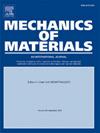Stress transfer mechanism and interfacial debonding behavior of composites with axially graded interphase
IF 3.4
3区 材料科学
Q2 MATERIALS SCIENCE, MULTIDISCIPLINARY
引用次数: 0
Abstract
In this paper, we explore the stress distributions of the composites with axially graded interphase, a newly proposed configuration. A three-phase shear-lag model considering the modulus gradient in the axial direction is developed and its validity in resolving the stress distributions is carefully verified with the help of finite element method. The results suggest that the shear stress concentration at the interphase/matrix interface can be significantly alleviated by introducing the functionally graded interphase. The parameter analysis indicates that longer length of functionally graded part, thicker interphase, smaller end modulus of the interphase, and lower convexity of interphase modulus profile, can enhance the effect on reducing the shear stress concentration. In addition, the introduction of functionally graded interphase also changes the debonding behavior of the composites: the onset of the debonding is postponed and the process of debonding is altered. Besides, we find that debonding on the two interfaces of the composites generally follow different trends when varying the geometrical and mechanical parameters of the interphase, which means that, by properly designing these parameters, one can easily modulate the failure modes of the composites.
轴向梯度界面相复合材料的应力传递机制及界面脱粘行为
本文探讨了带有轴向梯度相间层的复合材料的应力分布,这是一种新提出的结构。我们建立了一个考虑到轴向模量梯度的三相剪切滞后模型,并借助有限元方法仔细验证了该模型在解决应力分布问题上的有效性。结果表明,通过引入功能分级相间层,可显著缓解相间层/基体界面处的剪应力集中。参数分析表明,较长的功能分级部件长度、较厚的相间层、较小的相间层端面模量和较低的相间层模量曲线凸度都能增强降低剪应力集中的效果。此外,引入功能分级相还会改变复合材料的脱粘行为:推迟脱粘的开始时间并改变脱粘过程。此外,我们还发现,当改变中间相的几何和机械参数时,复合材料两个界面上的脱粘一般会呈现不同的趋势,这意味着通过适当设计这些参数,可以轻松调节复合材料的失效模式。
本文章由计算机程序翻译,如有差异,请以英文原文为准。
求助全文
约1分钟内获得全文
求助全文
来源期刊

Mechanics of Materials
工程技术-材料科学:综合
CiteScore
7.60
自引率
5.10%
发文量
243
审稿时长
46 days
期刊介绍:
Mechanics of Materials is a forum for original scientific research on the flow, fracture, and general constitutive behavior of geophysical, geotechnical and technological materials, with balanced coverage of advanced technological and natural materials, with balanced coverage of theoretical, experimental, and field investigations. Of special concern are macroscopic predictions based on microscopic models, identification of microscopic structures from limited overall macroscopic data, experimental and field results that lead to fundamental understanding of the behavior of materials, and coordinated experimental and analytical investigations that culminate in theories with predictive quality.
 求助内容:
求助内容: 应助结果提醒方式:
应助结果提醒方式:


